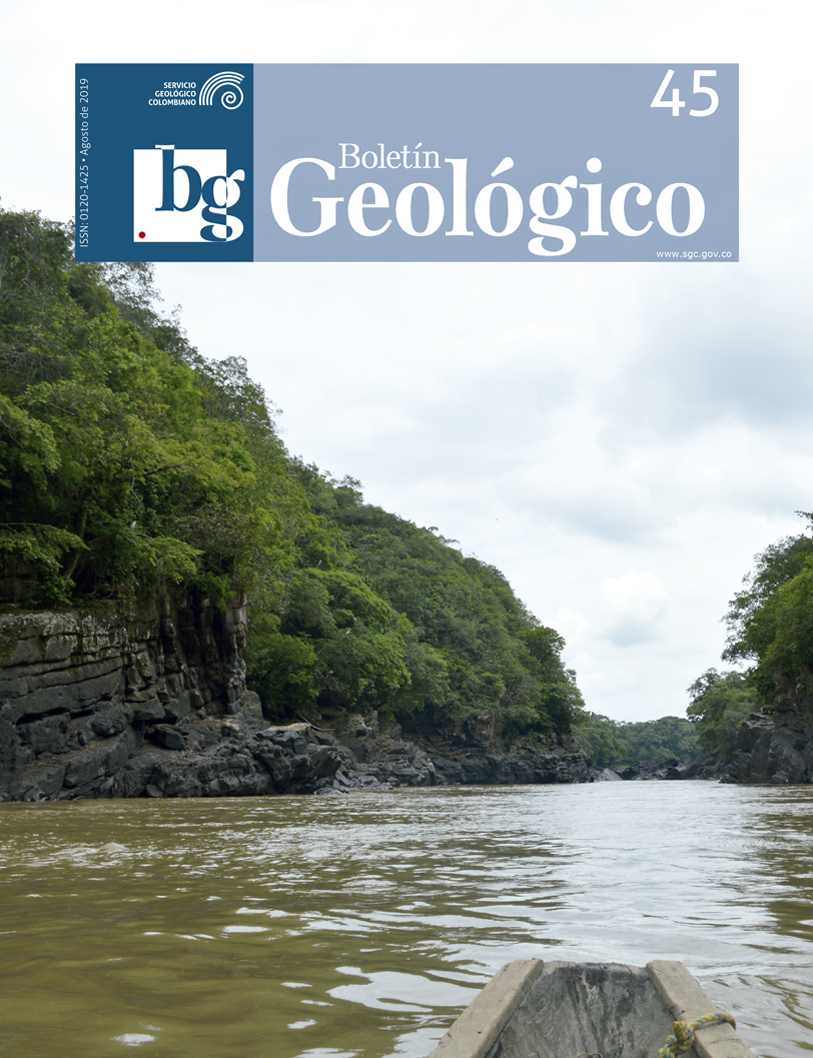Contribution to the geological knowledge of the Serranía del Perijá mountain range through 1:25,000 scale mapping of the Cogollo Group in the eastern sector of the municipality of Becerril, Cesar
DOI:
https://doi.org/10.32685/0120-1425/boletingeo.45.2019.487Keywords:
Cartography, Cogollo Group, Serranía del PerijáDownloads
How to Cite
Issue
Section
Published
Abstract
In the department of Cesar, Municipality of Becerril, there are extensive outcroppings of Cretaceous rocks with calcareous sequences belonging to the Lagunitas and Aguas Blancas Formations, the Cogollo Group, and the La Luna Formation. This study presents the mapping of a 25 km2 are in the eastern sector of the Municipality of Becerril, intended to contribute geological knowledge of this area through field work, identification of geomorphological units and petrographic descriptions at a scale 1:25,000. The Lagunitas Formation is characterized by a succession of dark gray massive fossiliferous limestone intercalated with calcareous mudstone and lumachellic limestone. From the Aguas Blancas Formation, the Ánimas Member is identified in detail, consisting of calcareous mudstone with abundant organic matter interbedded with black micritic limestones that grades horizontally to sandstones with fine-grained calcareous cement. The Tucuy Member consists of calcareous siltstone, fine-grained sandstone and carbonated claystone. The Maracas Member consists mainly of massive lumachellic limestone. Similarly, four geomorphological environments were identified: structural, identifying units of hog-backs, homoclinal ridges and cuestas; denudation, identifying units such as erosion scarps, lightly bisected hills and undulating interfluves; karstic, with units of karstic valley and karstic slope; and fluvial, with the floodplain unit.
References
Cáceres, C., Cediel, F. y Ujueta, G. (1976). Mapa geológico de Colombia, a escala 1:1’000.000. Bogotá: Ingeominas.
Castro, A. (1989). Petrografía básica: textura, clasificación y nomenclatura de rocas. Madrid: Paraninfo.
Castro, E. (2009). Aspectos geológicos y principales consideraciones de la evaluación ambiental estratégica (diagnóstico ambiental) del distrito minero La Jagua, departamento del Cesar. Bucaramanga: UIS.
Colmenares, F. H., Mesa, A., Roncancio, J., Arciniegas, E., Pedraza, P., Cardona, A. et al. (2007). Geología de las planchas 11, 12, 13, 14, 18, 19, 20, 21, 25, 26, 27, 33, 34 y 40. Proyecto: evolución geohistórica de la Sierra Nevada de Santa Marta. Bogotá: Ingeominas.
Dickinson, W. R. (1985). Interpreting provenance relations from detrital modes of sandstones. En G. G. Zuffa (ed.), Provenance of arenites (pp. 333-361). Dordrecht: Reidel Publ. Doi: https://doi.org/10.1007/978-94-017-2809-6_15.
Dunham, R. J. (1962). Classification of carbonate rocks according to depositional texture. En W. E. Ham (ed.), Classification of carbonate rocks. Memoir 1 (pp. 108-121). Tulsa: AAPG.
Flügel, E. (2004). Microfacies of carbonate rocks analysis, interpretation and application. Berlin-Heidelberg: Sprmger-Verlag. Doi: https://doi.org/10.1007/978-3-662-08726-8.
Folk, R. L. (1962). Clasificación de las rocas de carbonatos de acuerdo a las proporciones relativas de los tres constituyentes básicos: granos (aloquimicos), matriz micrítica y cemento, esparítico (ortoquímicos). Boletín Asociación Americana de Geólogos del Petróleo, 43.
Gardner, A. H. (1926). Suggested nomenclature and correlation of geological formations in Venezuela. Transactions of the American Institute of Mining and Metallurgical Engineers, 677-684.
Geoestudios, Ltda. (2006). Cartografía geológica cuenca Cesar-Ranchería. Informe final. Bogotá: Ministerio de Minas Y Energía, Agencia Nacional de Hidrocarburos.
Gil, A. y Martínez, H. (1990). Análisis microfacial del grupo Cogollo, y formación La Luna, cuenca Cesar-Ranchería, Guajira, Colombia (trabajo de grado, Geología). Bogotá: Universidad Nacional de Colombia, Departamento de Geociencias.
González, H., Salinas, R., Barbosa, A., Muñoz, C., Gallego, C., Quintero, D. et al.(2015). Mapa geológico de la Plancha 41 Becerril. Escala 1:100 000. Bogotá: Servicio Geológico Colombiano.
González, M., Mier, R., Arias, A., Cortés, Y., Moreno, M., Salazar, O. et al. (2008). Prospectividad de la cuenca Cesar-Ranchería. Contrato 27 de 2007 entre la Universidad Industrial de Santander y la Agencia Nacional de Hidrocarburos. Bucaramanga. Disponible en http://www.anh.gov.co/Informacion-Geologica-y-Geofisica/Estudios-Integrados-y-Modelamientos/Presentaciones%20y%20Poster%20Tcnicos/Cesar_Rancheria.pdf
Hernández, M. (2003). Memoria explicativa geología Plancha 48, Jagua de Ibirico. Escala 1:100.000. Bogotá: Ingeominas.
Hernández Sampieri, R. F. (2014). Metodología de la investigación (6.ª ed.). México: Mc Graw Hill.
Liddle, R. A. (1928). Barraquin Formation. En The geology of Venezuela and Trinidad. Fort Worth: J. P. Mc-Gowan, 108-103.
Miller, J. B. (1960). Directrices tectónicas en la sierra de Perijá y partes adyacentes de Venezuela y Colombia. Memoria. III Congreso Geológico Venezolano, Caracas.
Servicio Geológico Colombiano (2017). Mapa geomorfológico aplicado a movimientos en masa, escala 1:100.000. Sistema de Información de Movimientos en Masa (SIMMA). Bogotá: SGC.
Wilson, J. L. (1975). Carbonate facies in geologic history. Berlin: Springer.









